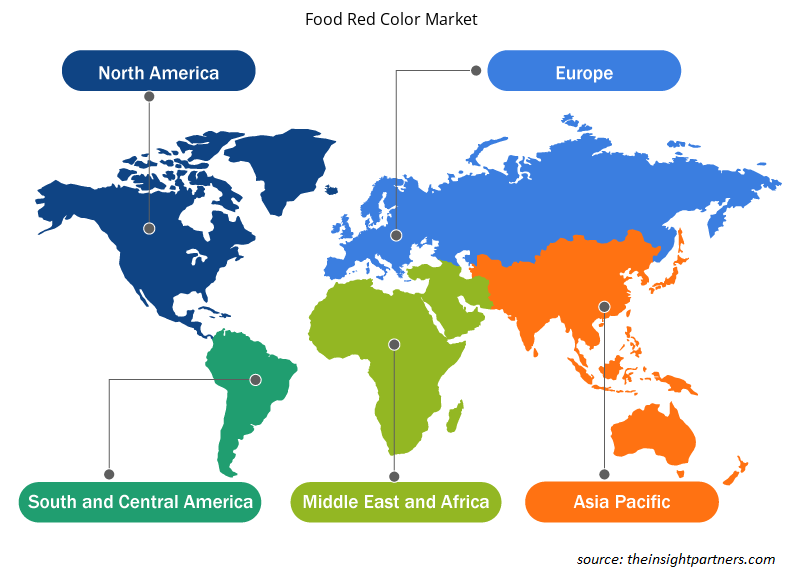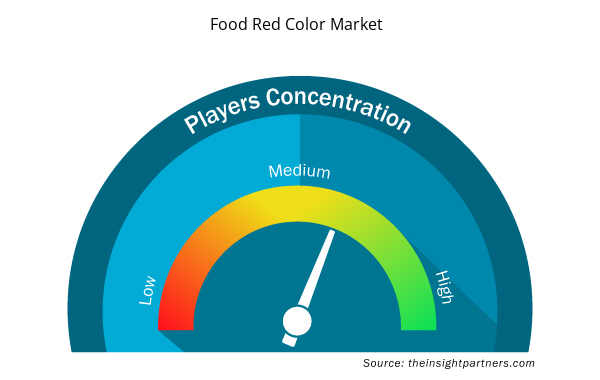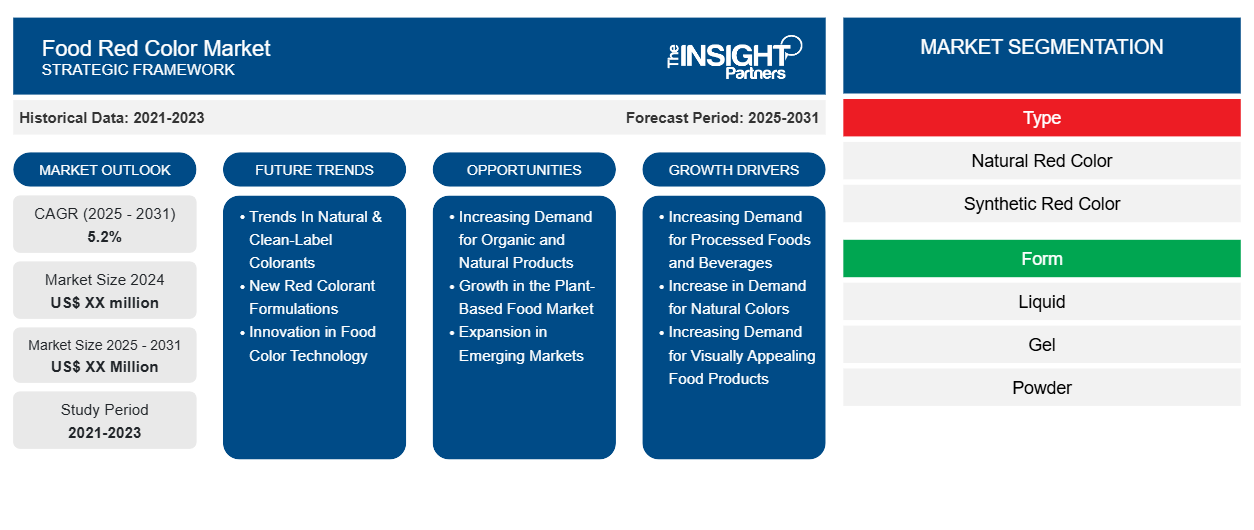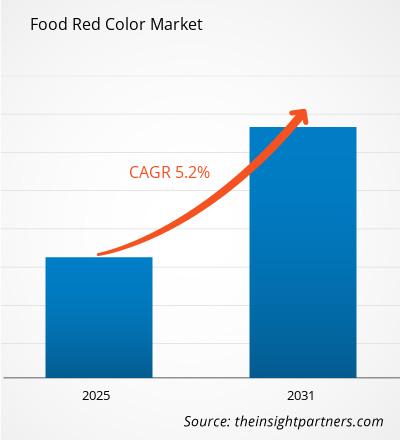Le marché du colorant rouge alimentaire devrait enregistrer un TCAC de 5,2 % de 2024 à 2031, avec une taille de marché passant de XX millions USD en 2024 à XX millions USD d'ici 2031.
Le marché des colorants alimentaires rouges est classé par type en colorant rouge naturel et colorant rouge synthétique, et par forme, c'est-à-dire liquide, gel et poudre. Il explore en outre des applications telles que les aliments transformés, les produits de boulangerie et de confiserie, la viande de volaille et les fruits de mer, les huiles et les graisses, les produits laitiers, les jus et les concentrés de jus, les boissons gazeuses et autres. Les prévisions jusqu'en 2031 offrent un aperçu de l'impact des réglementations et des préférences des consommateurs pour les colorants naturels sur la croissance du marché et les normes de l'industrie. L'analyse mondiale est ventilée au niveau régional et par principaux pays. L'évaluation du marché est présentée en dollars américains pour l'analyse segmentaire ci-dessus.
Objectif du rapport
Le rapport Food Red Color Market de The Insight Partners vise à décrire le paysage actuel et la croissance future, les principaux facteurs moteurs, les défis et les opportunités. Cela fournira des informations à diverses parties prenantes commerciales, telles que :
- Fournisseurs/fabricants de technologie : pour comprendre l’évolution de la dynamique du marché et connaître les opportunités de croissance potentielles, leur permettant de prendre des décisions stratégiques éclairées.
- Investisseurs : Effectuer une analyse complète des tendances concernant le taux de croissance du marché, les projections financières du marché et les opportunités qui existent tout au long de la chaîne de valeur.
- Organismes de réglementation : Réglementer les politiques et surveiller les activités du marché dans le but de minimiser les abus, de préserver la confiance des investisseurs et de maintenir l’intégrité et la stabilité du marché.
Segmentation du marché de la couleur rouge alimentaire
Taper
- Couleur rouge naturelle
- Colorant synthétique rouge
Formulaire
- Liquide
- Gel
- Poudre
Application
- Aliments transformés
- Produits de boulangerie et de confiserie
- Viandes, volailles et fruits de mer
- Huiles et graisses
- Produits laitiers
- Jus et concentrés de jus
- Boissons gazeuses non alcoolisées
- Autres
Géographie
- Amérique du Nord
- Europe
- Asie-Pacifique
- Amérique du Sud et Amérique centrale
- Moyen-Orient et Afrique
Personnalisez ce rapport en fonction de vos besoins
Vous bénéficierez d'une personnalisation gratuite de n'importe quel rapport, y compris de certaines parties de ce rapport, d'une analyse au niveau des pays, d'un pack de données Excel, ainsi que de superbes offres et réductions pour les start-ups et les universités.
- Obtenez les principales tendances clés du marché de ce rapport.Cet échantillon GRATUIT comprendra une analyse de données, allant des tendances du marché aux estimations et prévisions.
Facteurs de croissance du marché des colorants alimentaires rouges
- Demande croissante d'aliments transformés et de boissons : la demande croissante de produits alimentaires attrayants, en particulier dans les secteurs des boissons et de la confiserie, stimule le marché des colorants alimentaires rouges pour colorer les boissons, les bonbons et les aliments emballés.
- Augmentation de la demande de colorants naturels : Alors que les consommateurs achètent davantage de produits naturels, la demande de colorants rouges naturels comme l'extrait de betterave et l'extrait d'hibiscus augmente également, et les fabricants ont cessé d'utiliser des colorants rouges synthétiques et se sont tournés vers des alternatives naturelles.
- Demande croissante de produits alimentaires visuellement attrayants : Les principaux moteurs du marché de la couleur rouge alimentaire sont la demande croissante des consommateurs pour des produits alimentaires visuellement attrayants et attrayants. Le rouge est perçu comme un aliment appétissant, savoureux et gourmand, ce qui en fait le choix le plus populaire pour colorer des produits tels que les bonbons, les boissons, les gâteaux et les sauces. L'attrait esthétique des aliments de couleur rouge est tout à fait impératif pour l'achat du consommateur, en particulier dans les segments tels que la confiserie, les boissons et les snacks.
Tendances futures du marché de la couleur rouge alimentaire
- Tendances en matière de colorants naturels et « clean label » : dans le cadre de la tendance « clean label », les consommateurs commencent à vouloir des colorants rouges qui ne sont pas fabriqués à partir de produits chimiques. C'est cette tendance qui encourage les sources naturelles telles que le jus de betterave, le paprika et l'extrait de cochenille.
- Nouvelles formulations de colorants rouges : les progrès dans l’extraction et les compositions de colorants rouges aident les producteurs à prolonger la stabilité, la durée de conservation et la résistance à la chaleur des colorants rouges afin qu’ils puissent être utilisés dans un plus grand nombre d’aliments.
- Innovation dans la technologie des colorants alimentaires : L'industrie des colorants alimentaires connaît des efforts de recherche et de développement qui produisent des innovations améliorant la qualité, la stabilité et l'efficacité des colorants rouges. Les avancées technologiques ont permis le développement de colorants naturels plus stables et durables, capables de résister aux rigueurs de la transformation des aliments, notamment à la chaleur, à la lumière et aux variations de pH. Ceci, associé à la satisfaction de la forte demande de colorants naturels à base de plantes, encouragera les efforts visant à rechercher de nouvelles méthodes d'extraction de pigments rouges naturels.
Opportunités de marché pour la coloration rouge des aliments
- Demande croissante de produits biologiques et naturels : à mesure que les industries alimentaires biologiques et naturelles se développent, le marché des colorants alimentaires rouges présente un grand potentiel de croissance en fournissant des pigments naturels pour les produits certifiés biologiques.
- Croissance du marché des aliments d'origine végétale : les aliments d'origine végétale sont en hausse, ce qui ouvre la possibilité d'utiliser des pigments rouges d'origine végétale pour séduire les régimes végétaliens et végétariens, où les composants naturels sont plus que jamais nécessaires.
- Expansion sur les marchés émergents : les opportunités sont énormes pour le marché des colorants alimentaires rouges dans les marchés émergents, en particulier en Asie-Pacifique, en Amérique latine et au Moyen-Orient. Avec l’augmentation des revenus disponibles et des niveaux d’urbanisation, les régions affichent des niveaux de consommation plus élevés d’aliments transformés et emballés, d’où un besoin accru de colorants alimentaires. Les entreprises peuvent s’adresser à ces marchés émergents en lançant des solutions de colorants alimentaires abordables, qui comprendront des colorants rouges synthétiques et naturels, en fonction des préférences des consommateurs locaux.
Aperçu régional du marché de la couleur rouge alimentaire
Les tendances régionales et les facteurs influençant le marché du colorant alimentaire rouge tout au long de la période de prévision ont été expliqués en détail par les analystes d’Insight Partners. Cette section traite également des segments et de la géographie du marché du colorant alimentaire rouge en Amérique du Nord, en Europe, en Asie-Pacifique, au Moyen-Orient et en Afrique, ainsi qu’en Amérique du Sud et en Amérique centrale.

- Obtenez les données régionales spécifiques au marché du colorant alimentaire rouge
Portée du rapport sur le marché des colorants alimentaires rouges
| Attribut de rapport | Détails |
|---|---|
| Taille du marché en 2024 | XX millions de dollars américains |
| Taille du marché d'ici 2031 | XX millions de dollars américains |
| Taux de croissance annuel composé mondial (2024-2031) | 5,2% |
| Données historiques | 2021-2023 |
| Période de prévision | 2025-2031 |
| Segments couverts | Par type
|
| Régions et pays couverts | Amérique du Nord
|
| Leaders du marché et profils d'entreprises clés |
|
Densité des acteurs du marché des colorants alimentaires rouges : comprendre son impact sur la dynamique commerciale
Le marché des colorants alimentaires rouges connaît une croissance rapide, tirée par la demande croissante des utilisateurs finaux en raison de facteurs tels que l'évolution des préférences des consommateurs, les avancées technologiques et une plus grande sensibilisation aux avantages du produit. À mesure que la demande augmente, les entreprises élargissent leurs offres, innovent pour répondre aux besoins des consommateurs et capitalisent sur les tendances émergentes, ce qui alimente davantage la croissance du marché.
La densité des acteurs du marché fait référence à la répartition des entreprises ou des sociétés opérant sur un marché ou un secteur particulier. Elle indique le nombre de concurrents (acteurs du marché) présents sur un marché donné par rapport à sa taille ou à sa valeur marchande totale.
Les principales entreprises opérant sur le marché du colorant rouge alimentaire sont :
- SMA
- Chr. Hansen
- Dowdupont
- Technologies sensibles
- DSM
Avis de non-responsabilité : les sociétés répertoriées ci-dessus ne sont pas classées dans un ordre particulier.

- Obtenez un aperçu des principaux acteurs clés du marché de la couleur rouge alimentaire
Principaux arguments de vente
- Couverture complète : Le rapport couvre de manière exhaustive l’analyse des produits, des services, des types et des utilisateurs finaux du marché des colorants rouges alimentaires, offrant un paysage holistique.
- Analyse d’experts : Le rapport est compilé sur la base d’une compréhension approfondie des experts et analystes du secteur.
- Informations à jour : Le rapport garantit la pertinence commerciale en raison de sa couverture des informations récentes et des tendances des données.
- Options de personnalisation : ce rapport peut être personnalisé pour répondre aux exigences spécifiques du client et s'adapter parfaitement aux stratégies commerciales.
Le rapport de recherche sur le marché des colorants alimentaires rouges peut donc aider à ouvrir la voie au décodage et à la compréhension du scénario de l’industrie et des perspectives de croissance. Bien qu’il puisse y avoir quelques préoccupations valables, les avantages globaux de ce rapport ont tendance à l’emporter sur les inconvénients.
- Analyse historique (2 ans), année de base, prévision (7 ans) avec TCAC
- Analyse PEST et SWO
- Taille du marché Valeur / Volume - Mondial, Régional, Pays
- Industrie et paysage concurrentiel
- Ensemble de données Excel



Report Coverage
Revenue forecast, Company Analysis, Industry landscape, Growth factors, and Trends

Segment Covered
This text is related
to segments covered.

Regional Scope
North America, Europe, Asia Pacific, Middle East & Africa, South & Central America

Country Scope
This text is related
to country scope.
Questions fréquemment posées
Some of the customization options available based on request are additional 3-5 company profiles and country-specific analysis of 3-5 countries of your choice. Customizations are to be requested/discussed before making final order confirmation, as our team would review the same and check the feasibility.
The report can be delivered in PDF/PPT format; we can also share excel dataset based on the request.
Key companies in this market are- ADM, Chr. Hansen, Dowdupont, Sensient Technologies, DSM, Naturex, DDW, Döhler Group, Fiorio Colori,
The market is expected to register a CAGR of 5.2% during 2023-2031.
Future trends include an increasing demand for natural red colorants, innovations in extraction methods, and growing consumer preference for non-GMO and organic products.
The food red color market is driven by the demand for visually appealing foods, the growing preference for natural and plant-based colorants, and regulatory approvals for food-safe colorants.
Trends and growth analysis reports related to Food and Beverages : READ MORE..
1. ADM
2. Chr. Hansen
3. Dowdupont
4. Sensient Technologies
5. DSM
6. Naturex
7. DDW
8. Döhler Group
9. Fiorio Colori
10. Kalsec
The Insight Partners performs research in 4 major stages: Data Collection & Secondary Research, Primary Research, Data Analysis and Data Triangulation & Final Review.
- Data Collection and Secondary Research:
As a market research and consulting firm operating from a decade, we have published and advised several client across the globe. First step for any study will start with an assessment of currently available data and insights from existing reports. Further, historical and current market information is collected from Investor Presentations, Annual Reports, SEC Filings, etc., and other information related to company’s performance and market positioning are gathered from Paid Databases (Factiva, Hoovers, and Reuters) and various other publications available in public domain.
Several associations trade associates, technical forums, institutes, societies and organization are accessed to gain technical as well as market related insights through their publications such as research papers, blogs and press releases related to the studies are referred to get cues about the market. Further, white papers, journals, magazines, and other news articles published in last 3 years are scrutinized and analyzed to understand the current market trends.
- Primary Research:
The primarily interview analysis comprise of data obtained from industry participants interview and answers to survey questions gathered by in-house primary team.
For primary research, interviews are conducted with industry experts/CEOs/Marketing Managers/VPs/Subject Matter Experts from both demand and supply side to get a 360-degree view of the market. The primary team conducts several interviews based on the complexity of the markets to understand the various market trends and dynamics which makes research more credible and precise.
A typical research interview fulfils the following functions:
- Provides first-hand information on the market size, market trends, growth trends, competitive landscape, and outlook
- Validates and strengthens in-house secondary research findings
- Develops the analysis team’s expertise and market understanding
Primary research involves email interactions and telephone interviews for each market, category, segment, and sub-segment across geographies. The participants who typically take part in such a process include, but are not limited to:
- Industry participants: VPs, business development managers, market intelligence managers and national sales managers
- Outside experts: Valuation experts, research analysts and key opinion leaders specializing in the electronics and semiconductor industry.
Below is the breakup of our primary respondents by company, designation, and region:

Once we receive the confirmation from primary research sources or primary respondents, we finalize the base year market estimation and forecast the data as per the macroeconomic and microeconomic factors assessed during data collection.
- Data Analysis:
Once data is validated through both secondary as well as primary respondents, we finalize the market estimations by hypothesis formulation and factor analysis at regional and country level.
- Macro-Economic Factor Analysis:
We analyse macroeconomic indicators such the gross domestic product (GDP), increase in the demand for goods and services across industries, technological advancement, regional economic growth, governmental policies, the influence of COVID-19, PEST analysis, and other aspects. This analysis aids in setting benchmarks for various nations/regions and approximating market splits. Additionally, the general trend of the aforementioned components aid in determining the market's development possibilities.
- Country Level Data:
Various factors that are especially aligned to the country are taken into account to determine the market size for a certain area and country, including the presence of vendors, such as headquarters and offices, the country's GDP, demand patterns, and industry growth. To comprehend the market dynamics for the nation, a number of growth variables, inhibitors, application areas, and current market trends are researched. The aforementioned elements aid in determining the country's overall market's growth potential.
- Company Profile:
The “Table of Contents” is formulated by listing and analyzing more than 25 - 30 companies operating in the market ecosystem across geographies. However, we profile only 10 companies as a standard practice in our syndicate reports. These 10 companies comprise leading, emerging, and regional players. Nonetheless, our analysis is not restricted to the 10 listed companies, we also analyze other companies present in the market to develop a holistic view and understand the prevailing trends. The “Company Profiles” section in the report covers key facts, business description, products & services, financial information, SWOT analysis, and key developments. The financial information presented is extracted from the annual reports and official documents of the publicly listed companies. Upon collecting the information for the sections of respective companies, we verify them via various primary sources and then compile the data in respective company profiles. The company level information helps us in deriving the base number as well as in forecasting the market size.
- Developing Base Number:
Aggregation of sales statistics (2020-2022) and macro-economic factor, and other secondary and primary research insights are utilized to arrive at base number and related market shares for 2022. The data gaps are identified in this step and relevant market data is analyzed, collected from paid primary interviews or databases. On finalizing the base year market size, forecasts are developed on the basis of macro-economic, industry and market growth factors and company level analysis.
- Data Triangulation and Final Review:
The market findings and base year market size calculations are validated from supply as well as demand side. Demand side validations are based on macro-economic factor analysis and benchmarks for respective regions and countries. In case of supply side validations, revenues of major companies are estimated (in case not available) based on industry benchmark, approximate number of employees, product portfolio, and primary interviews revenues are gathered. Further revenue from target product/service segment is assessed to avoid overshooting of market statistics. In case of heavy deviations between supply and demand side values, all thes steps are repeated to achieve synchronization.
We follow an iterative model, wherein we share our research findings with Subject Matter Experts (SME’s) and Key Opinion Leaders (KOLs) until consensus view of the market is not formulated – this model negates any drastic deviation in the opinions of experts. Only validated and universally acceptable research findings are quoted in our reports.
We have important check points that we use to validate our research findings – which we call – data triangulation, where we validate the information, we generate from secondary sources with primary interviews and then we re-validate with our internal data bases and Subject matter experts. This comprehensive model enables us to deliver high quality, reliable data in shortest possible time.


 Obtenez un échantillon gratuit pour ce rapport
Obtenez un échantillon gratuit pour ce rapport